REFLECTIONS OF AN EXISTENTIAL CRISIS IN
SØREN KIERKEGAARD’S AESTHETIC CONCEPTION
REFLECTIONS OF AN EXISTENTIAL CRISIS IN
SØREN KIERKEGAARD’S AESTHETIC CONCEPTION
Author(s): Antanas AndrijauskasSubject(s): History of Philosophy, Philosophical Traditions, Special Branches of Philosophy
Published by: Instytut Filozofii i Socjologii Polskiej Akademii Nauk i Fundacja Filozofia na Rzecz Dialogu
Keywords: Søren Kierkegaard; Novalis; Romantics; Georg Wilhelm Friedrich Hegel; Arthur Schopenhauer; Friedrich Nietzsche; nonclassical aesthetics; beauty, art; subjective ontology; existence; pseudonym; irony
Summary/Abstract: This article considers the principles of philosophical thinking in Søren Kierkegaard’s nonclassical aesthetics. Special attention is given to his radical critique of“false” and “impersonal” rationalism. This does not only mean the rejection of the traditional principles of classical metaphysics which claims “universality” and “universalmeaning.” Kierkegaard also bases his philosophy on individual human life, or, in otherwords, personal existence with its unique inner world. His critique is more profoundthan that by Arthur Schopenhauer. Kierkegaard develops his own philosophy of “existential crisis,” opposing subjective will and internal changes to abstract thinking andexternal influences. Kierkegaard’s works initiate the critical or nonclassical stage inWestern aesthetics. The main place in it is occupied by the idea of the disharmony ofthe world: its subjective reflection is “split” consciousness that has lost contact with thetraditional concepts of harmony, humanism, goodness, beauty and philosophy of art.His philosophy of art is that of the internal personal world and of free choice. Heopposes the famous motto of Cartesian rationalism cogito ergo sum, his own statement“I am here and think because I do exist here.” So the notion of existence becomes fundamental for his philosophical reflection which is focused on the topics of personalexistence, destiny and perspectives of being. Since personal becoming never stops, theability to exist is treated as a great art. The aim of genuine philosophy is not a knowledge of the external world but an inquiry into the deepest problems of personal being andcreativity; its greatest enigma is existence. Hence Kierkegaard gives a new subject andnew tasks to aesthetics and philosophy of art.When treating the problems of individual human existence, Kierkegaard and otherfollowers of nonclassical aesthetics relied on an understanding of being as nonsubstantial (personality is not something given but a totality of constantly emergingpotentials) and at the same time subjectivized their ontological problems. Thus the strengthening of subjectivist tendencies in the post-Hegelian philosophy of art reaches hereculmination. “Subjective ontology,” or “ontology” in the narrow sense of the word, isthat which we can call the “pontaneous ego:” It determines the unconscious functioning of human “existence” in a specific individual consciousness. The whole individual existence is enclosed, as it were, in a subjective environment, but we cannot affirm thatexistence is subjective.
Journal: Dialogue and Universalism
- Issue Year: 2019
- Issue No: 2
- Page Range: 29-41
- Page Count: 13
- Language: English
- Content File-PDF

